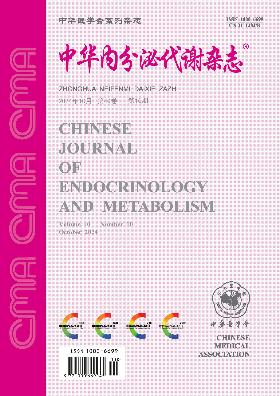中国大庆糖尿病预防研究中代谢健康肥胖对糖尿病、心血管疾病事件及其死亡率风险的长期影响
Q4 Medicine
引用次数: 0
摘要
目的通过23年的随访,探讨代谢健康型肥胖对2型糖尿病、心血管疾病事件及其死亡率的长期影响。方法根据口服糖耐量试验结果,于1986年入组519例糖耐量正常患者和630例新诊断的2型糖尿病患者,在大庆进行23年的长期临床随访。代谢健康肥胖被定义为没有代谢异常(糖尿病、高血压、高脂血症)的超重和肥胖个体。最后,我们确定了682名参与者(350名糖耐量正常,332名新诊断为糖尿病)。研究对象分为5组:代谢健康正常体重211例(MHNW组)、代谢健康超重肥胖58例(MHO组)、代谢不健康超重肥胖合并高血压(MUHO组)、2型糖尿病(MUDO组)、高血压合并糖尿病(MUHDO组)分别为81、109、223例。比较两组2型糖尿病的发病率、心血管疾病的发病率和死亡率。结果23年期间,MHO组2型糖尿病的发病率比MHNW组高2倍(24.1%,12.5/1 000人年vs 10.9%, 5.2/1 000人年,P=0.01),年龄、性别和吸烟史校正后的危险比(HR)为2.42 (95% CI 1.24 ~ 4.74, P=0.01)。代谢不健康的超重组和肥胖组的心血管疾病发病率和死亡率高于MHNW组,而MUHO、MUDO、MUHDO组的心血管疾病发病率和死亡率均高于MHNW组(P<0.05)。结论与代谢健康的正常体重参与者相比,代谢健康的肥胖组2型糖尿病的风险增加,但心血管疾病事件及其死亡率没有增加。相反,代谢异常的超重和肥胖组2型糖尿病的发病率、心血管疾病的发病率和死亡率均显著高于肥胖组。关键词:代谢健康型肥胖;2型糖尿病;死亡率;心血管疾病事件本文章由计算机程序翻译,如有差异,请以英文原文为准。
Long-term effects of metabolically healthy obesity on the risks of diabetes, cardiovascular disease events and its mortality over 23 years in the China Daqing diabetes prevention study
Objective
To investigate the long-term effects of metabolically healthy obesity on the risks of type 2 diabetes, cardiovascular disease events, and its mortality over a 23-year follow-up.
Methods
Based on the results of an oral glucose tolerance test, there were 519 participants with normal glucose tolerance and 630 with newly diagnosed type 2 diabetes enrolled in 1986 and then given to assess the long-term clinical outcomes during the 23-year follow-up in Daqing. Metabolically healthy obesity was defined as the overweight and obese individuals with no metabolic abnormalities (diabetes, hypertension, hyperlipidemia). Finally, we identified 682 participants (350 with normal glucose tolerance and 332 with newly diagnosed diabetes). They were divided into five groups: 211 individuals with metabolically healthy normal weight (MHNW group), 58 with metabolically healthy overweight and obesity (MHO group), 81, 109, 223 were metabolically unhealthy overweight and obesity with hypertension (MUHO group), type 2 diabetes (MUDO group), hypertension and diabetes (MUHDO group). Incidences of type 2 diabetes, morbidity and mortality of cardiovascular disease were compared among these groups.
Results
Over 23 years, instead of the morbidity and mortality of cardiovascular disease, the incidence of type 2 diabetes in MHO group was two times higher than in MHNW group ( 24.1%, 12.5/1 000 person years vs 10.9%, 5.2/1 000 person years, P=0.01), with an age, sex, and smoking history-adjusted hazard ratio (HR) of 2.42 (95% CI 1.24-4.74, P=0.01). The morbidity and mortality of cardiovascular disease in the groups of overweight and obesity with metabolically unhealthy were higher than in MHNW group, and increased across the subjects with MUHO, MUDO, MUHDO (P<0.05).
Conclusion
Compared with metabolically healthy normal weight participants, the metabolically healthy obese group was at increased risk of type 2 diabetes but not cardiovascular disease events and its mortality. On the contrary, the overweight and obese groups with metabolic abnormalities had significant higher incidence of type 2 diabetes, morbidity and mortality of cardiovascular diseases.
Key words:
Metabolically healthy obesity; Diabetes mellitus, type 2; Mortality; Cardiovascular disease events
求助全文
通过发布文献求助,成功后即可免费获取论文全文。
去求助
来源期刊

中华内分泌代谢杂志
Medicine-Endocrinology, Diabetes and Metabolism
CiteScore
0.60
自引率
0.00%
发文量
7243
期刊介绍:
The Chinese Journal of Endocrinology and Metabolism was founded in July 1985. It is a senior academic journal in the field of endocrinology and metabolism sponsored by the Chinese Medical Association. The journal aims to be the "Chinese broadcaster of new knowledge on endocrinology and metabolism worldwide". It reports leading scientific research results and clinical diagnosis and treatment experience in endocrinology and metabolism and related fields, as well as basic theoretical research that has a guiding role in endocrinology and metabolism clinics and is closely integrated with clinics. The journal is a core journal of Chinese science and technology (a statistical source journal of Chinese science and technology papers), and is included in Chinese and foreign statistical source journal databases such as the Chinese Science and Technology Papers and Citation Database, Chemical Abstracts, and Scopus.
 求助内容:
求助内容: 应助结果提醒方式:
应助结果提醒方式:


